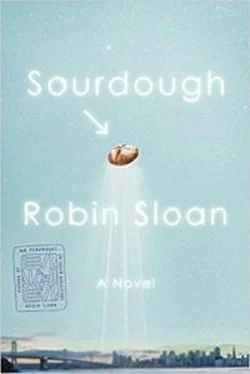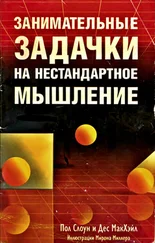I was so confused I didn’t know what questions to ask. Was it real? Was it worth my time? Where was it?
“Hello, baker,” the queen of the underworld said. “You weren’t selected for one of the main markets, which means I’m free to make an offer. I’m Lily Belasco. I manage the Marrow Fair.”
“What … is … the Marrow Fair?”
She fished something out of her leather jacket. It looked like what was left after you finish a chicken drumstick, but when I accepted it, I realized it wasn’t real bone. Instead, it was made from beige plastic, some kind of high-grade polymer, warm and smooth, almost buttery. There was a ring attached to one end, as if to dangle it from a key chain.
“That’s a key to my market,” Lily Belasco said. “This offer is contingent. But I want you to see the place before you decide.”
“Contingent? On what?”
“I’ll send you directions. Just come visit. Then decide.”
A LOT OF MAZG WORK in kitchens because (not to sound too haughty, but) we’re really very good at it. All the restaurants with Michelin stars, where you can eat salted moss and turnip foam—I guarantee you’ll find Mazg working there! I did that in Edinburgh before, at a really excellent restaurant. The owner just found out I was back, and he asked me if I wanted to return. I turned him down. (Nicely.) I’ve decided I want to open my own restaurant, like in San Francisco, but this time I’m not going to be so cautious about it. I’m not going to be so Mazg!
Lois, I’m telling you before anyone else:
I’m going to have tables.
ALAMEDA
IT WAS SEVEN P.M. when I slunk out of the office with the Clement Street starter in its ceramic crock. Instead of heading home, I walked around the curve of the Embarcadero to the Ferry Building. This time, my destination wasn’t the gourmet arcade inside, but the piers beyond. I boarded the boat bound for the skinny island shouldered up against Oakland on the far side of the bay: Alameda.
The trip was shorter than I expected. Soon, we were passing the Port of Oakland and its loading cranes. They looked like the bleached skeletons of prehistoric quadrupeds, Godzilla-scale, with monstrous pulleys in their guts lifting bright containers out of long freighters that dwarfed the ferry.
We bumped up against the dock at Alameda. I disembarked onto a wide parking lot, now mostly empty, and hiked up the road toward the coordinates I’d been given.
I’d never set foot on Alameda before. It had once been home to a sprawling naval base, but that had been decommissioned decades ago, and what remained in its place was a weedy moonscape dotted with military-scale buildings inhabited by small businesses, like hermit crabs in overlarge shells. I passed a distillery, a furniture emporium, and a drone manufacturer, each in its own aircraft hangar.
I stopped to check my directions. YES, KEEP WALKING, Lily Belasco had written.
Behind the hangars, there was a huge expanse of abandoned asphalt, cracked and overtaken by vegetation. There were tall grasses and low, tight shrubs with gray-green leaves and bright white blossoms.
I walked across the broken surface, feeling illicit; but there were no fences, no signs telling me to KEEP OUT. It seemed derelict. I passed a hangar-turned-brewery; this was Algebra, whose beers I’d tasted at fancy bars in San Francisco. Their flagship brew was the x 2 Saison.
Out on the airfield, a herd of goats was grazing. They bleated and cried and retreated as I approached, little bells jingling around their necks. It was an unexpected sight: the goats scattered across the vast empty asphalt, gnawing on the patchy grass, and behind them the mirrored quadruped forms of the cranes, snuffling their noses in the holds of the great freighters.
Maybe the cranes would also be improved by bells around their necks.
Among the goats, there were two taller figures. One was an alpaca. It stood in the center of the flock, its gaze tracking me coolly. The other figure was a young man with a rumpled skater look.
I waved, as if signaling a ship, and called out to him. “Hello?”
The man waved lazily, but remained as silent and baleful as his alpaca accomplice. They both cast very long shadows.
“I’m looking for a market,” I shouted. Standing there on the asphalt, it seemed like an absurd statement.
He nodded slowly at this. We were still standing very far apart. The man’s aspect and the alpaca’s were approximately equivalent: wary, not unfriendly, but fundamentally alien. After a long pause, the man pointed toward the old control tower.
I waved again and walked in that direction.
When I reached the tower, its front door was propped open. I poked my head inside; it appeared long abandoned, scraped clean of furniture and ornament. Spiraling metal steps wound their way upward. Climbing them, I found myself on the tower’s bulbous deck with a panoramic view of the airfield and the island and the bay. The window’s edge was decorated, through all 360 degrees, with beer bottles, all with Algebra labels. The last of the day’s sunlight filtered through them, casting blobs of green light around the room.
The spiraling metal steps returned me to the tower’s front door and also continued down into the ground. There was a landing below. I descended and found another door, this one locked tight, blank and gray except for a palm-sized outline stenciled in creamy white paint.
The stencil’s shape looked like what was left after you finished a chicken drumstick.
The door offered no knob, no handle, no doorbell, no speakeasy slit. I tried to knock, but the metal hurt my knuckles. I thumped it with my palm. Nothing.
I drew out the buttery plastic bone token I’d received at the Ferry Building and pressed it against the stencil. From unseen speakers, a synthesized voice bellowed like a buzz saw:
STILL —
TOO —
SKINNY.
And the door opened.
WHILE I WAS IN SAN FRANCISCO with Chaiman, I sometimes had the thought that perhaps the two of us were like the bacteria and the fungus in the starter—a tiny self-sufficient community.
(In that analogy, I am the bacteria and Chaiman is the fungus. Never tell him I said that.)
Chaiman hardly ever comes out of his room anymore. He’s working on his album nonstop. He’s been talking about it for two years, but something happened after we left San Francisco. He got serious. He follows all the excruciatingly cool music—I don’t even understand where he finds it—and he says, “Mazg singing will blow their minds.” He’s taking the old recordings, cutting them up, transforming them. And, of course, adding a beat. He loves making the beats.
The bacteria stands alone.
PINK LIGHT
I WALKED INTO A SPACE that was long and narrow with the powered-down gloom of a high school at night, a raw concrete concourse with portals all along its edges. Bars of pink light streamed in from those portals and made me think of the prom spilling out of the gym, except here there were many proms, and many gyms, and all were silent. The smooth floor was marked with stripes of paint that had flaked into segments—directions that no one had followed in a long time.
It felt, also, like an empty spaceship, and, as a rule, you do not enter an empty spaceship without first knowing the fate of the crew.
But the floor offered fresher directions, too. Extending away from the door, long strips of yellow tape marked an angling path, and along that path workstations were set up, built from unstained lumber bolted across metal frames supporting kitchen gear and lab equipment. Some workstations had ranges with burners chunky like the grilles of semitrucks. Ventilation hoods whirred softly.
Читать дальше










